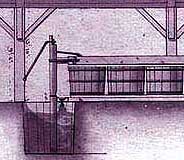
 |
The
La Forte Collection, 1783-1797
|
|
Collection Description The La Forte Collection contains correspondence, instructional material, technical drawings, financial records and other official documents drawn from the archives of Benoist La Forte, commissaire and then Inspector General for the French Ministry of Gunpowder. The more than 3, 000 items in the collection span the period from 1784 to 1797, thus documenting the entirety of La Forte's training and administrative career with the Régie des poudres et salpêtres. There is a small number of printed items, and a good portion of the incoming correspondence appears on paper with French Revolution letterhead. The contents of the collection are arranged into three broad categories: general documents and manuscripts dating from 1784 to 1797; correspondence from 1786 to 1793; and correspondence from 1793 to 1797. There is in addition some earlier correspondence from previous occupants of La Forte's positions. Most of the pieces in the collection date from 1793-1797, a period of rapid reform and expansion in French gunpowder manufacture during which La Forte was Inspector for Vaucluse. Well-known figures whose names appear in the collection include Antoine François de Fourcroy, and noted chemists Antoine Laurent Lavoisier and Jean Antoine Claude Chaptal de Chanteloup. Among the more general material there are documents concerning La Forte, such as his letters of appointment, commissions, etc.; a chemistry textbook from 1785 and notes -- from La Forte's years as a student and beyond -- on various aspects of the science and technology of gunpowder manufacture; and a set of instructions, disseminated throughout France, for Inspectors of gunpowder and saltpetre, probably composed by Lavoisier and addressing every aspect of the manufacturing process. A detailed record of La Forte's administration is provided by summaries of its operations submitted annually to the Régie for the years 1787 to 1797. These reports gather together correspondence to and from the Régie, financial records, inventories, estimates for new construction, etc. Complementing this archive is a series of annual accounts, many signed by Lavoisier, and receipts from the Régie. Chief correspondents include the Régie des poudres et salpêtres at the central office in Paris, headed by Lavoisier and four other régisseurs (the Régie became l'Agence des poudres et salpêtres in 1794); the Comité de Salut Public, for a time the chief executive organ of the revolutionary government; the Representants du Peuple, who were members of the National Assembly; government agents; government-appointed instructors who were often the leading chemists of France; local administrators, writing from all parts of France; and the salt and saltpetre workers (salpêtriers and saliniers) representing the lowest ranks of the gunpowder industry. Many of these functionaries were expedient, transiently powerful creations of the revolutionary government, concerned with shoring up support for the new republic, and enforcing the observation of revolutionary legislation during a time of war. Topics covered include: methods of gunpowder manufacture; technological improvements and administrative reform; results of production; stimulating production; accounts; problems procuring raw materials (especially saltpetre and combustibles) and equipment; fixing the price of saltpetre; the construction of factories, refineries and workshops; abuses, such as the clandestine production and private sale of saltpetre; accidents; the effect of the Revolution on industry (including revolutionary surveillance and opposition to revolutionary legislation); Parisian politics; the French economy; the shift to paper currency; workers' salaries; and dissatisfaction among the workers. Correspondence from the workers themselves, of which there is a substantial amount, provides information about local administration, conditions in the workshops, the effects of inflation on workers and production, and the various technical and logistical problems encountered from day to day. Jean V. Callahan (Compiled with the aid of French Books and Manuscripts: 1700-1830, An exhibition and Description of Collections in Cornell University Library honoring Arthur H. And Mary Marden Dean. Ithaca: Cornell University Library, 1981.) |
 |
|||||
| Copyright
© 2002 Division of Rare & Manuscript
Collections For information about copyright issues and securing permission to publish digital reproductions of images from the La Forte collection, please consult our Copyright & Permissions Page. For reference
questions, send mail to:mailto:rareref@cornell.edu |
|||||